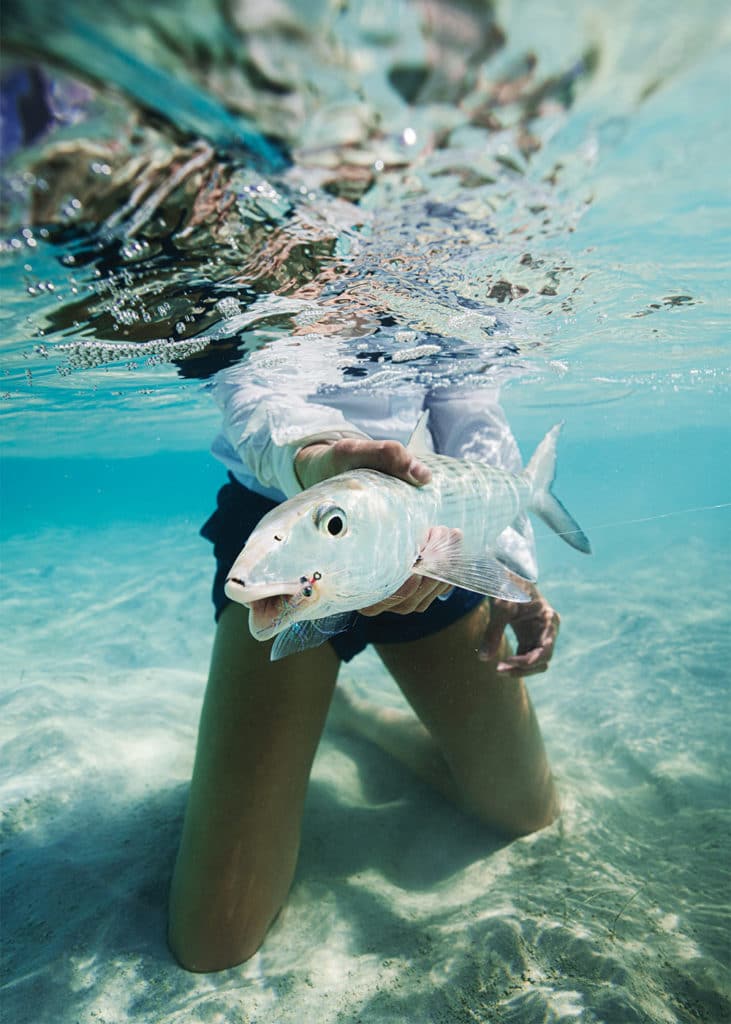
No matter how many times you fly into the Out Islands of the Bahamas, the -palette of blue, aqua and turquoise spreading across the shallows engenders wonder and promise. You immediately imagine yourself stalking bonefish on foot or hunting them from a poled skiff.
We’d fish those flats, but not for a couple of days. Seven of us—the SWS crew—flew to Stella Maris Resort on Long Island for our annual planning meetings, followed by a couple of days of bonefishing. Of our group, only two had bonefishing miles under their wading boots. The other five were in for a brisk and total immersion in fly-fishing for this dimunitive big game of the flats, a bucket-list experience for many anglers, but a challenging introduction to fly-rodding.
The evening before our first outing, we assembled for a fly-casting shakedown. James “Docky” Smith, who runs the fishing program at Stella Maris, made the rounds, offering casting tips, and assessing what he and the other guides would be dealing with.

With any new fishing experience, the first day can be tough. Getting used to a new environment and unfamiliar tackle, and just looking for a groove can eat up the day. Day two -usually brings success, and often on day three, it all comes -together. Quality tackle, willing fish and good guides are essential for bonefishing success. We had all of that. Still, we’d surely be pushing the limits of our novices, the guides and the fishing itself.
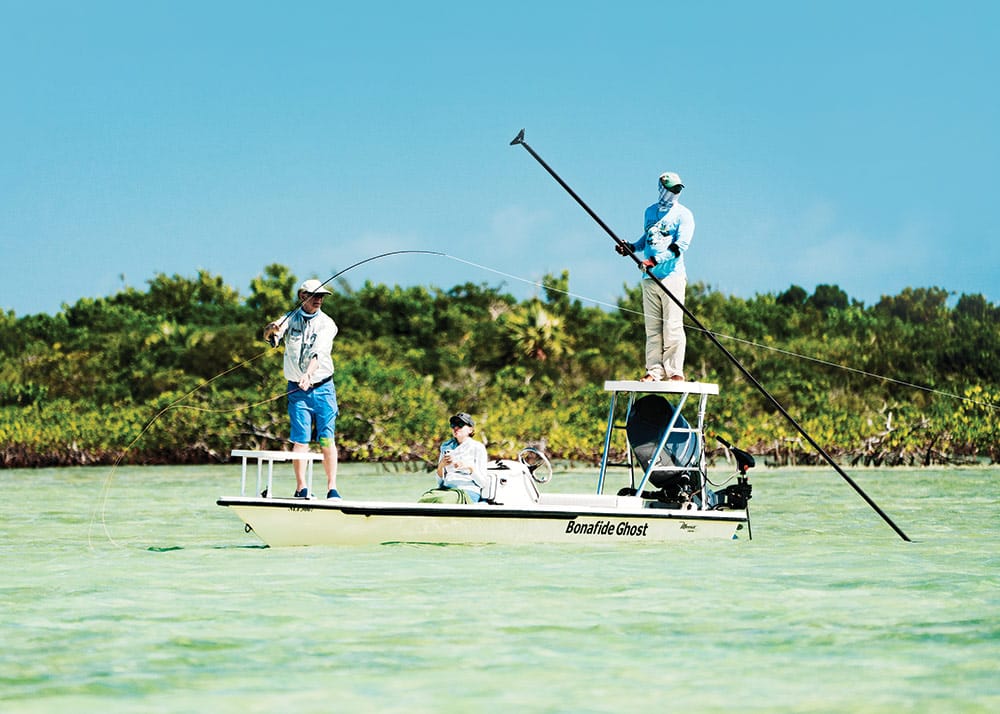
The fishing grounds at the north end of Long Island lie a short run from the -marina, which is just a quick jaunt from Stella Maris. A run around Dove Point reveals the flats of Glenton Sound on the leeward side of the island, protected from the open Atlantic, offering a wealth of habitats, from mangrove creeks to wide-open sand flats.
The bonefishing is straighforward: From the bow of the skiffs, we -hunted the perimeter of the sound, where the fish that venture deep into the mangroves with the high tide begin to move out, feeding across the flats as the water falls.
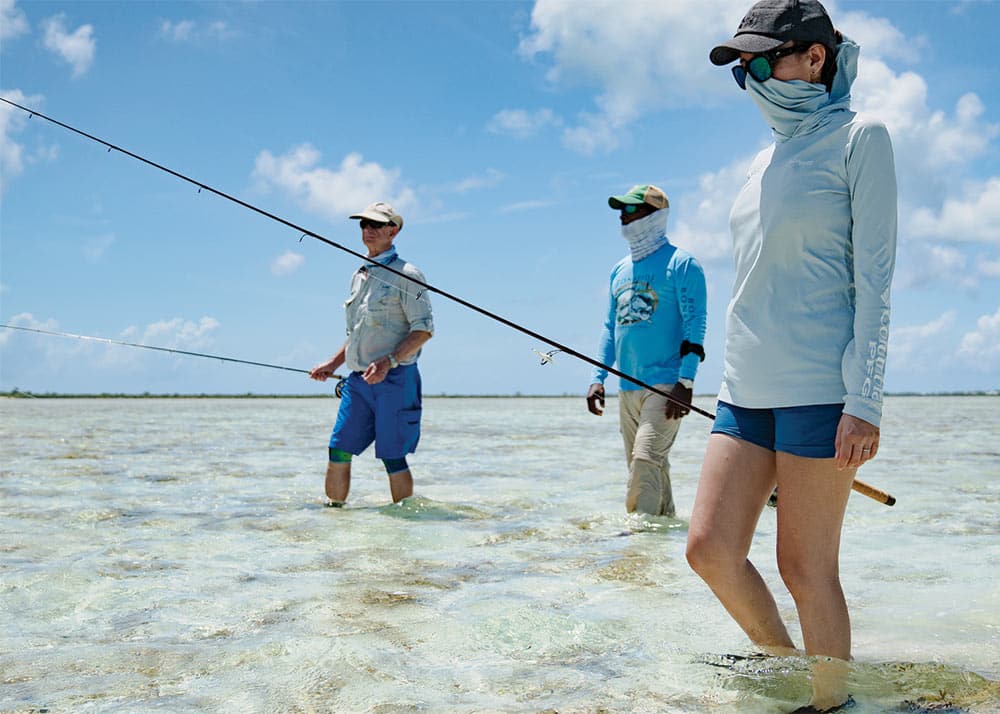
Once the water shallowed, we abandoned the boats and stalked the bonefish on foot. Wading conditions varied from perfect, packed-sand flats to -challenging miniature mogul fields, but the fish were there.
“I know where they are,” Smith explained. “These are my fish.” They very well could be, but we still had to catch them.
Art Director Mile Wambold, an experienced offshore angler, decided that fly-casting was not for her, but she took to the light spinning outfit like a seasoned hand. As she and Senior Editor Alex Suescun stalked fish along the mangrove -edges, she tossed a skimmer jig ahead of a cruising school and tied into the largest bonefish anyone saw during our time in Long Island: a bruiser pushing 8 pounds that headed for the safety of the nearby channel at blazing speed, then managed to spit the jig.
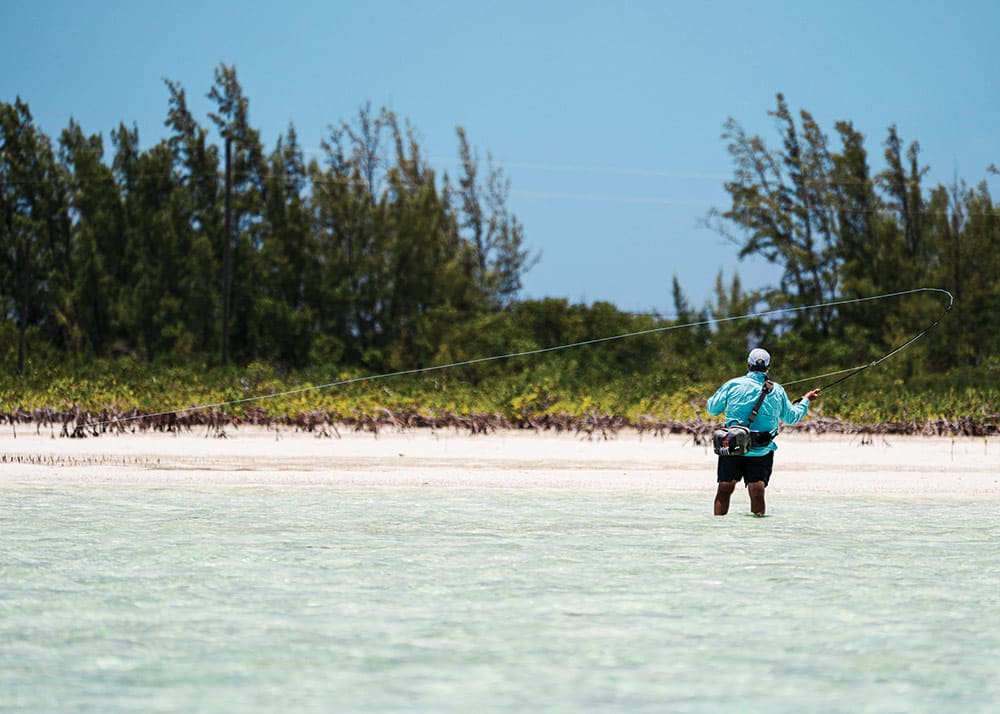
During the short but exhilarating fight, a hungry lemon shark, attracted by the commotion, moved in and began to circle her. Her exhilaration increased to the downside, but she held her ground, flipped the jig in front of the shark, and the lemon quickly latched on. With the jig lodged amidships in its upper lip, Wambold fought and landed the 5-footer despite the lack of a leader, scoring the release on 8-pound line.
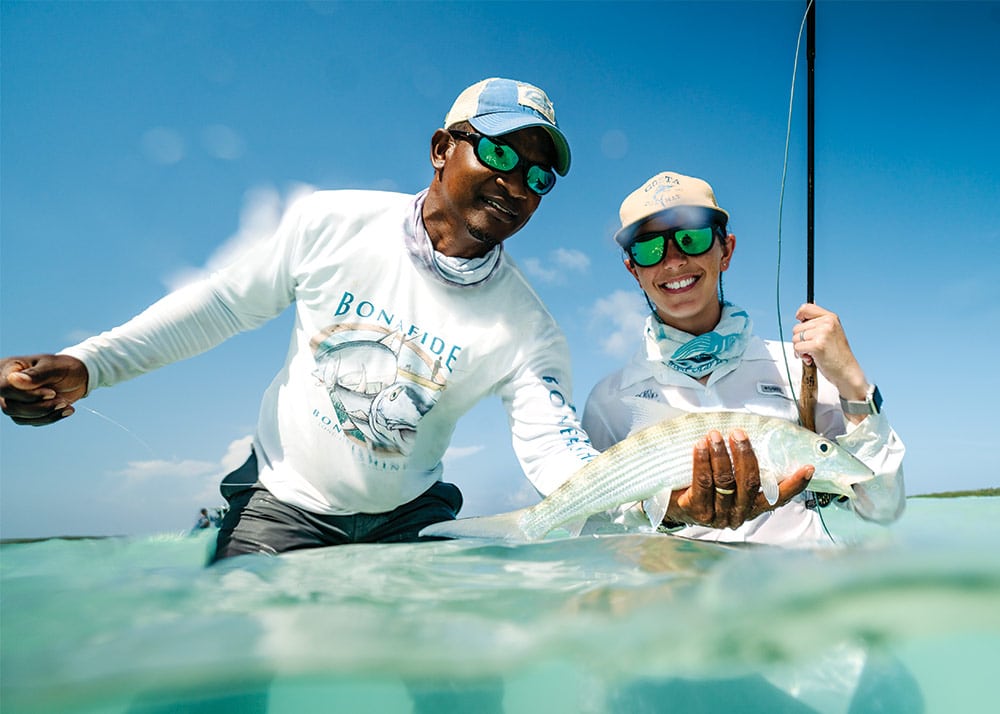
Having spent her entire life fishing with spinning -tackle, Digital Content Specialist Jackie Fry had taken an interest in fly-casting for the -appeal of doing it all herself, and this trip was her long-awaited -gateway to the sport.
Unlike a lot of other fishing, she says, “with fly-fishing, it’s up to you to do everything and catch the fish.” What she hadn’t counted on was the excitement factor when fish came into range.
“It was hard,” Fry says, “to keep the rhythm under control and not get excited. When fish showed up, it was hard to stay calm enough to cast. After the first day with no fish, I was down on myself, really discouraged. I was ready to call it quits,” but stalking the schools afoot, it all came together, and the second morning, things turned around. With Smith’s coaching, she dropped the fly in front of a tailer, the line came tight, and her first bonefish on a fly beelined for the horizon. “Hooking that fish—only the fourth time I’d ever held a fly rod—brought my confidence back,” she says. On a roll now, she released two more fish before we headed to the dock.
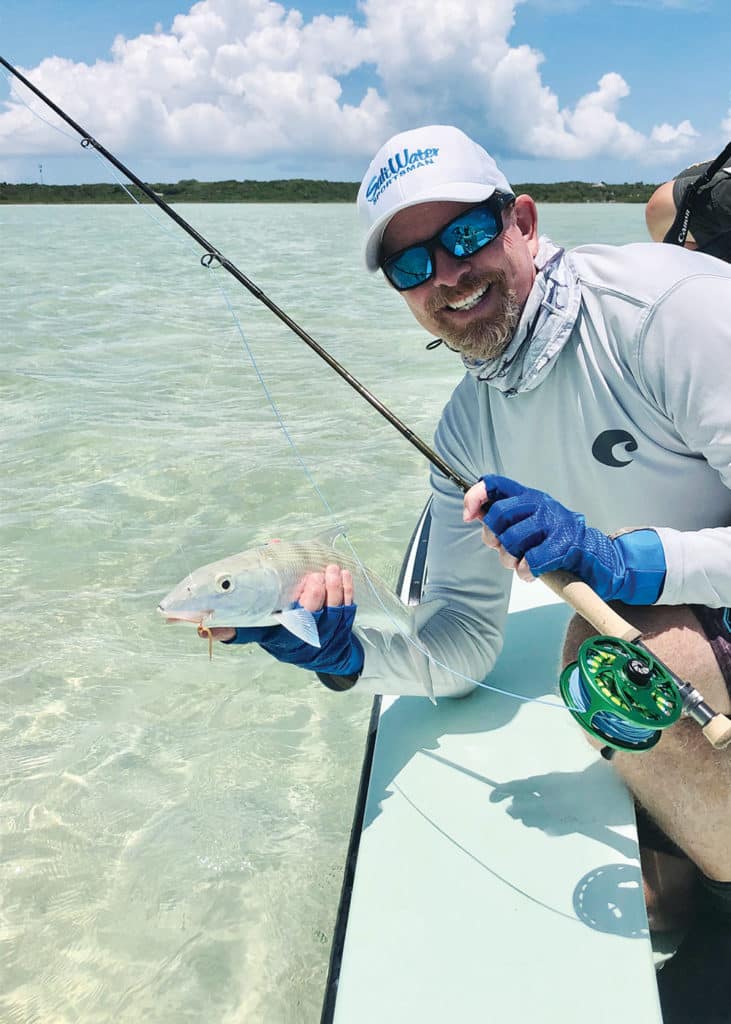
Our second and final day of flats–fishing ended with a 50 percent success rate: Group Publisher Scott Salyers and Digital Content Director Mark MacKenzie remained fishless.
So, the next day, when the rest of us headed out for some fun-fishing on the nearby reefs, MacKenzie and Salyers, not to be denied their fly-caught bonefish credentials, opted for a third day on the flats with Smith.
Any guide or casting instructor will tell you women are easier to teach than men. The latter, as a tribe, arrive with all the knowledge they think they need. Then they have to unlearn what they think they know so they can learn something. It seems as if that held true.
Salyers had some -offshore fly-rod experience—the chuck-and-flop for dolphin and sailfish kind—but hunting individual fish in shallow water proved a different story.
“I tried to absorb what the guide told me,” Salyers says. “But I was trying to do too much -because I thought I knew what I was doing.”
He’d gotten the fly to willing fish on a few -occasions, but every time, “the wheels just came off,” he says.
Finally, “I just tried to wipe the slate clean, and eliminate all my preconceived notions,” Salyers says. And that’s when his growing skills and Smith’s guidance came together.
“He set me up to cast, put the boat in the right place, and my timing clicked,” says Salyers, who finally landed his well-earned first bonefish.
Salyers’ confidence came back quickly. One fish is often all it takes. “I feel like if you put a fly rod in my hand now, I’m apt to make it happen,” he says.
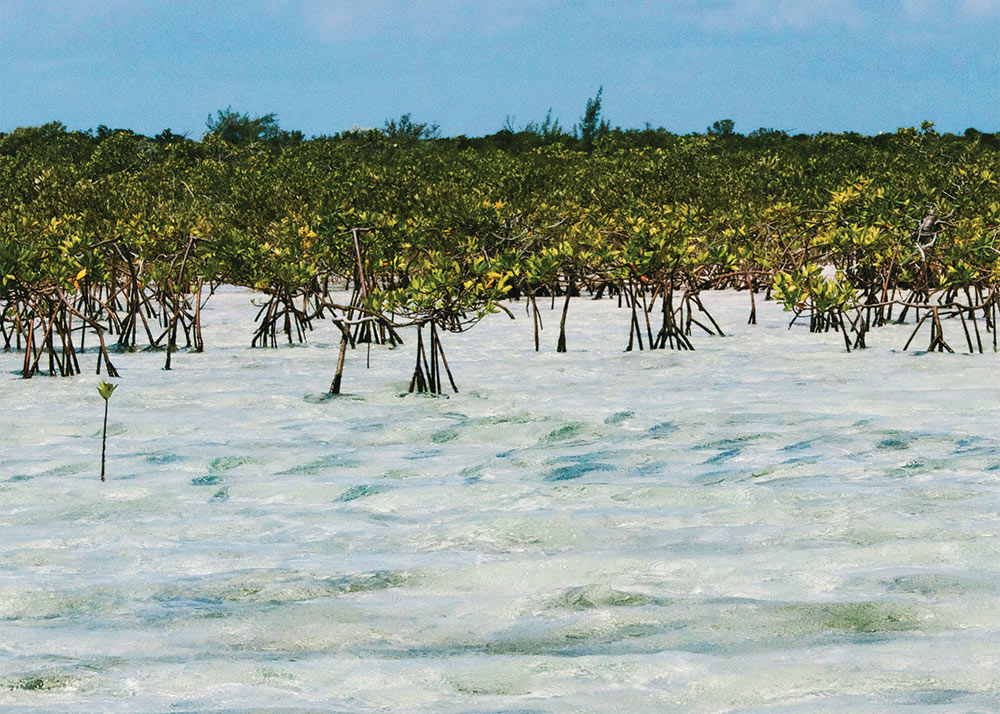
As a seasoned striped bass -fisherman with decades of fly-casting behind him, MacKenzie had never applied his Northeastern skills to southern bonefish. The biggest challenge he found? “Panic,” he says. “I’d never cast to fish at such close range before. When the guide puts you on a fish that looks like a guarantee, the adrenalin kicks in, and I totally flailed.”
Every fish that hit his fly offered a new lesson, from stalking to the -particular hook-set bonefish demand.
But if anything, MacKenzie is an -angler. He took his lumps in stride and persevered. As his old habits fell away, he adapted to the species and the situation at hand, calmed himself down, and got the job done.
We flew home with a crew of seasoned flats -anglers, all with success stories under their belts and a new appreciation for the sweeps of blue and green shallows below, as Stella Maris slowly fell behind us.
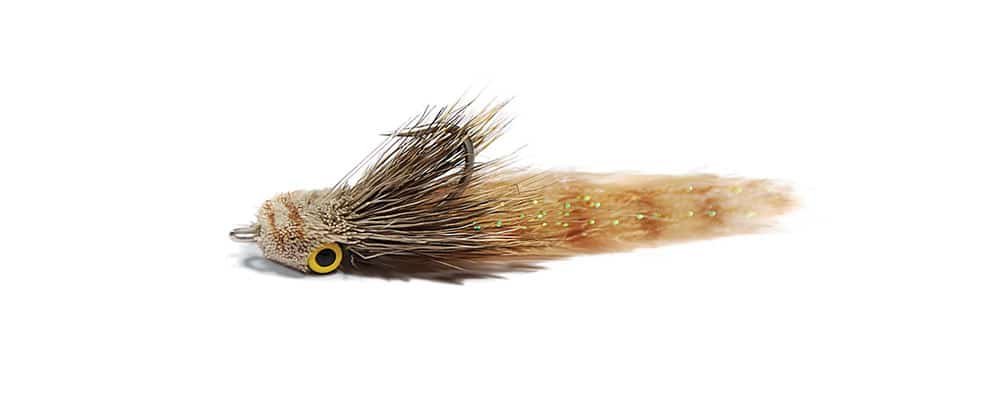
SWS Planner
What: Bonefish
Where: Long Island, Bahamas
Who: James “Docky” Smith, a top-notch flats guide in Long Island, runs an independent guiding service (bonafidebonefishing.com), and also reserves additional guides to serve small groups of anglers.
Rods: 9-foot, 7- to 9-weight fly rod, such as G. Loomis IMX-PRO or equivalent
Reels: Fly reel sized to a balance rod, with a smooth drag and 150 yards of backing
Line: Bonefish or saltwater taper (floating or intermediate), with 9- to 12-foot leaders ending in 8- to 12-pound tippet
Flies: Shrimpy-looking and buggy patterns, such as the Borski Bonefish Slider or Gotcha, with bead chain or small lead eyes, in size 4
Other: Polarized sunglasses are a must for spotting cruising bonefish, and wading boots are recommended for walking the flats. Tackle is available for rent at Stella Maris, but most anglers prefer to bring their own familiar gear.
Postscript: As for our fifth initiate? We never let photographer Jon Whittle put down his cameras long enough to fish.
Undaunted and remembering what he’d learned, Whittle scored a seatrout, his first fly-rod fish, a couple of weeks later, bringing—in a roundabout way—the success rate of our fly-fishing expedition to 100 percent.









